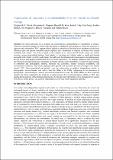Files in this item
Trajectories of exposure and vulnerability of small islands to climate change
Item metadata
| dc.contributor.author | Duvat, Virginie K. E. | |
| dc.contributor.author | Magnan, Alexandre K. | |
| dc.contributor.author | Wise, Russell M. | |
| dc.contributor.author | Hay, John E. | |
| dc.contributor.author | Fazey, Ioan | |
| dc.contributor.author | Hinkel, Jochen | |
| dc.contributor.author | Stojanovic, Tim | |
| dc.contributor.author | Yamano, Hiroya | |
| dc.contributor.author | Ballu, Valérie | |
| dc.date.accessioned | 2018-05-31T23:33:05Z | |
| dc.date.available | 2018-05-31T23:33:05Z | |
| dc.date.issued | 2017-11 | |
| dc.identifier | 250129857 | |
| dc.identifier | a911d77e-f40a-42f9-a91d-672ab822f548 | |
| dc.identifier | 85019986515 | |
| dc.identifier | 000412835200003 | |
| dc.identifier.citation | Duvat , V K E , Magnan , A K , Wise , R M , Hay , J E , Fazey , I , Hinkel , J , Stojanovic , T , Yamano , H & Ballu , V 2017 , ' Trajectories of exposure and vulnerability of small islands to climate change ' , Wiley Interdisciplinary Reviews: Climate Change , vol. 8 , no. 6 , e478 . https://doi.org/10.1002/wcc.478 | en |
| dc.identifier.issn | 1757-7780 | |
| dc.identifier.other | ORCID: /0000-0002-8936-2299/work/64697660 | |
| dc.identifier.uri | https://hdl.handle.net/10023/13652 | |
| dc.description | The authors thank the funding and logistical supports for the Back to the Future workshop (France, October 8–10, 2013) provided by the Corderie Royale de Rochefort, the Regional Council of Poitou-Charentes, the Conservatoire du Littoral, the Fondation de France, the Club Méditerranée, the Communautés d'agglomération de La Rochelle et du Pays Rochefortais, and the Université populaire du Littoral Charentais 17 and the French National Research Agency (CapAdapt project, ANR-2011-JSH1-004 01 and STORISK project, ANR-15-CE03-0003). | en |
| dc.description.abstract | This article advocates for a dynamic and comprehensive understanding of vulnerability to climate-related environmental changes in order to feed the design of adaptation future pathways. It uses the trajectory of exposure and vulnerability (TEV) approach that it defines as ‘storylines of driving factors and processes that have influenced past and present territorial system exposure and vulnerability to impacts associated with climate variability and change.’ The study is based on the analysis of six peer-reviewed Pacific island case studies covering various geographical settings (high islands vs low-lying reef islands, urban vs rural) and hazards associated with climate variability and change; that addressed the interactions between natural and anthropogenic driving factors; and adopted multidecadal past-to-present approaches. The findings emphasize that most urban and rural reef and high islands have undergone increasing exposure and vulnerability as a result of major changes in settlement and demographic patterns, lifestyles and economies, natural resources availability, and environmental conditions. The article highlights three generic and successive periods of change in the studied islands’ TEV: from geopolitical and political over the colonization-to-political independence period; to demographic, socio-economic, and cultural from the 1960s to the 1980s; culminating in the dominance of demographic, socio-economic, cultural, and environmental drivers since the 1980s. Based on these empirical insights, the article emphasizes the existence of anthropogenic-driven path-dependency effects in TEV, thus arguing for the analysis of the temporal dimensions of exposure and vulnerability to be a prerequisite for science to be able to inform policy- and decision-making processes toward robust adaptation pathways. | |
| dc.format.extent | 1695687 | |
| dc.language.iso | eng | |
| dc.relation.ispartof | Wiley Interdisciplinary Reviews: Climate Change | en |
| dc.subject | GE Environmental Sciences | en |
| dc.subject | T-NDAS | en |
| dc.subject | SDG 13 - Climate Action | en |
| dc.subject.lcc | GE | en |
| dc.title | Trajectories of exposure and vulnerability of small islands to climate change | en |
| dc.type | Journal article | en |
| dc.contributor.institution | University of St Andrews. Geography & Sustainable Development | en |
| dc.contributor.institution | University of St Andrews. Scottish Oceans Institute | en |
| dc.contributor.institution | University of St Andrews. St Andrews Sustainability Institute | en |
| dc.contributor.institution | University of St Andrews. Marine Alliance for Science & Technology Scotland | en |
| dc.identifier.doi | 10.1002/wcc.478 | |
| dc.description.status | Peer reviewed | en |
| dc.date.embargoedUntil | 2018-05-31 |
This item appears in the following Collection(s)
Items in the St Andrews Research Repository are protected by copyright, with all rights reserved, unless otherwise indicated.

